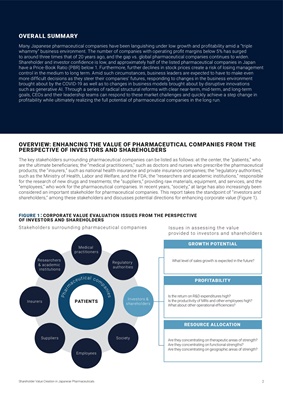
2
Shareholder Value Creation in Japanese Pharmaceuticals
OVERALL SUMMARY
Many Japanese pharmaceutical companies have been languishing under low growth and profitability amid a "triple
whammy" business environment. The number of companies with operating profit margins below 5% has surged
to around three times that of 20 years ago, and the gap vs. global pharmaceutical companies continues to widen.
Shareholder and investor confidence is low, and approximately half of the listed pharmaceutical companies in Japan
have a Price-Book Ratio (PBR) below 1. Furthermore, further declines in stock prices create a risk of losing management
control in the medium to long term. Amid such circumstances, business leaders are expected to have to make even
more difficult decisions as they steer their companies' futures, responding to changes in the business environment
brought about by the COVID-19 as well as to changes in business models brought about by disruptive innovations
such as generative AI. Through a series of radical structural reforms with clear near-term, mid-term, and long-term
goals, CEOs and their leadership teams can respond to these market challenges and quickly achieve a step change in
profitability while ultimately realizing the full potential of pharmaceutical companies in the long run.
OVERVIEW: ENHANCING THE VALUE OF PHARMACEUTICAL COMPANIES FROM THE
PERSPECTIVE OF INVESTORS AND SHAREHOLDERS
The key stakeholders surrounding pharmaceutical companies can be listed as follows: at the center, the "patients," who
are the ultimate beneficiaries; the "medical practitioners," such as doctors and nurses who prescribe the pharmaceutical
products; the "insurers," such as national health insurance and private insurance companies; the "regulatory authorities,"
such as the Ministry of Health, Labor and Welfare, and the FDA; the "researchers and academic institutions," responsible
for the research of new drugs and treatments; the "suppliers," providing raw materials, equipment, and services, and the
"employees," who work for the pharmaceutical companies. In recent years, "society," at large has also increasingly been
considered an important stakeholder for pharmaceutical companies. This report takes the standpoint of "investors and
shareholders," among these stakeholders and discusses potential directions for enhancing corporate value (Figure 1).
Stakeholders surrounding pharmaceutical companies Issues in assessing the value
provided to investors and shareholders
FIGURE 1:CORPORATE VALUE EVALUATION ISSUES FROM THE PERSPECTIVE
OF INVESTORS AND SHAREHOLDERS
Medical
practitioners
Regulatory
authorities
Investors &
shareholders
Society
Employees
Suppliers
Insurers
Researchers
& academic
institutions
PATIENTS
What level of sales growth is expected in the future?
Is the return on R&D expenditures high?
Is the productivity of MRs and other employees high?
What about other operational efficiencies?
Are they concentrating on therapeutic areas of strength?
Are they concentrating on functional strengths?
Are they concentrating on geographic areas of strength?
GROWTH POTENTIAL
PROFITABILITY
RESOURCE ALLOCATION
Pharmaceutical companies